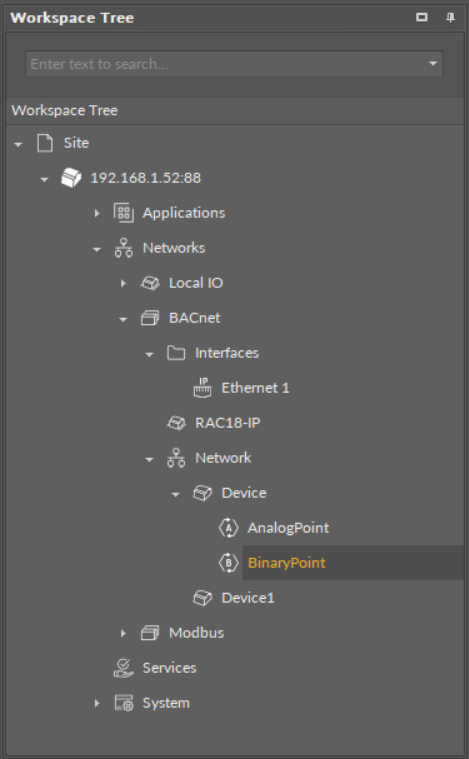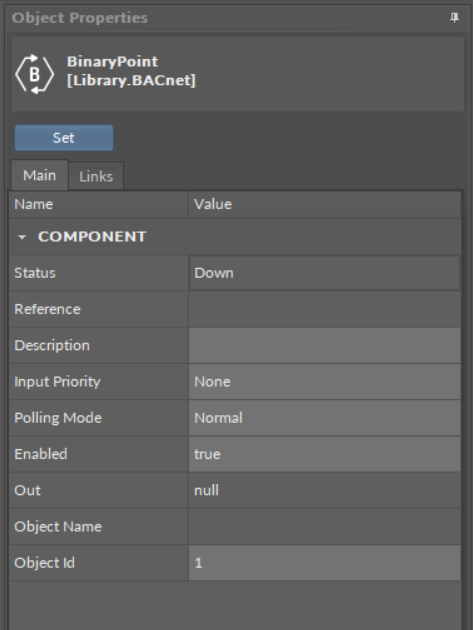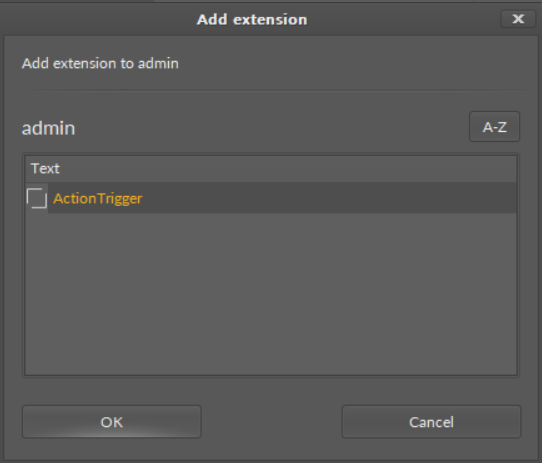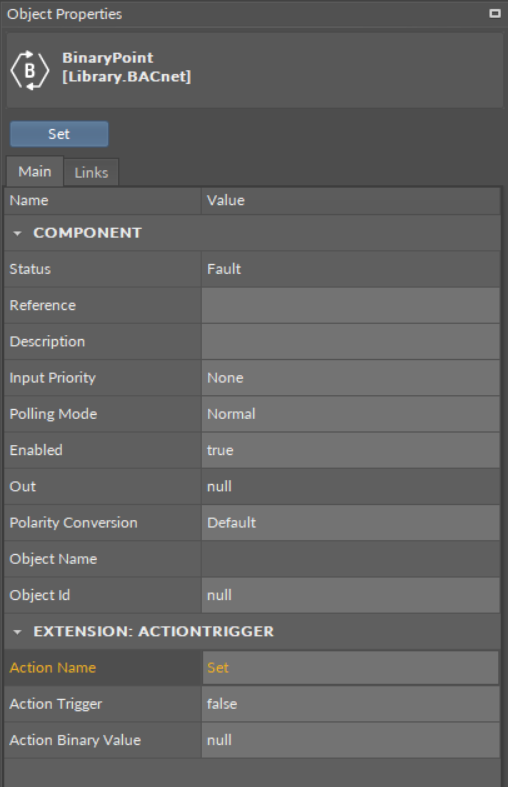The BinaryPoint component is a network point class component, which allows to read and write binary values to a defined BACnet Binary Value object in the remote device.
Note: Before using the component, make sure that its object ID is assigned and its Status is OK.
The BinaryPoint component includes an action that allows to set its Out value in case no Data Point class component is linked to it; the value is sent to the BACnet object with no priority.

The BinaryPoint component
The BinaryPoint component has the following slots:
-
Status: indicates the current status of the component; if the component works properly, its status is OK. The component becomes Disabled, once the Enabled slot is in false. The component's status is Fault, once the Object Id slot is null. If there is no response from the addressed point, the component goes into the Down status.Available information: Disabled, Fault, Down, OK.
-
Reference: a special slot allowing to connect network point class components with Data Point class components. It allows to transfer the Out slot value along with the component's status.
Note: Reference links from Data Points to network points also transfer values in the opposite direction, in a link-back-from process: having received a value by the Reference link, the network point transfers it back to the Data Point to whichever input priority from 1 to 16 is set in the network point.
-
Description: an additional detailed information about a component that may be freely described by the user; the description may contain individual coding, defined in the user's system documentation, meter's or sensor's location, or any other information the user finds applicable.
Note: The description is effectively added only if the point allows it–the description is not added internally in the RACIP-18 for the remote point, but it is sent directly to the point.
-
InputPriority: allows to indicate the input number in the Data Point, which the network point class component's output value is sent to, in case the network point detects the change on its Out slot; none priority is set by default.Available settings: none, 1-16.
-
Polling Mode: allows to set the frequency of sending polling requests for the point's value to remote devices—the polling mode is automatically set to normal;Available settings: fast, normal, slow;
-
Enabled: change of the slot's value enables or disables the component.Available settings: true (enabled), false (disabled).
Note: If the Enabled slot is in false (meaning the component is disabled), the Status slot becomes Disabled.
-
Out: a real value read from or written to the object of the remote device.
Note: If the component's Status is fault (e.g., an invalid value in the Object Id slot), the Out value is null.
-
Object Name: displays the BACnet remote device's point name;
-
Object Id: allows setting an address of the BACnet object in the remote device; once the component has been added, the slot's default value is null—for the component to operate properly, the unique address value must be set in this slot.
Note: Here, the Object Id regards the BACnet Binary Value object.
Find out more about the Reference linking.
The BinaryPoint component has the following action:
-
Set: sets a value to the Out slot—in case no Data Point is linked to the output network point, it is possible to set its Out value with this action.
Note: The value is sent to the BACnet object with no priority.

The BinaryPoint component slots
ActionTrigger Extension
The ActionTrigger extension is designed to invoke any action that is available for the component. The extension triggers an action selected in the Action Name on the rising edge of the Action Trigger slot. If the action has parameters to set, the parameter is taken from a relevant slot automatically added to the extension (Analog Value/Binary Value/String Value).
It is possible to add more than one ActionTrigger extension to the component (for example, one for each action in the component).
The extension is added from the context menu of the component.

The ActionTrigger extension has the following slots:
-
Action Name: allows to select an action to invoke;
-
Action Trigger: triggers an action selected in the Action Name slot;
-
Action Analog Value/Action Binary Value/Action String Value: a slot added automatically to the extension if an action selected in the Action Name slot has any specific parameters to set (depending on the type of action and its parameters, the relevant type of value is matched).

The ActionTrigger extension in the BinaryPoint component
